Essay on Corporate Sustainability, Stakeholders, and Partnerships
VerifiedAdded on 2022/08/20
|10
|3101
|12
Essay
AI Summary
This essay delves into the multifaceted realm of corporate sustainability, emphasizing its critical importance in contemporary business practices. It meticulously examines the significance of corporate sustainability, highlighting its role in achieving sustainable profits, fulfilling social responsibilities, and adopting environmentally conscious approaches. The essay underscores the crucial role of stakeholders, including employees, customers, and the government, in driving sustainable business performance. Furthermore, it critically evaluates the importance of stakeholder partnerships, demonstrating how collaborative arrangements can lead to improved decision-making, enhanced competitiveness, and the achievement of long-term organizational success. The essay provides examples of how companies like Nike, Bank, Apple and Woolworths are using sustainability to drive business performance and to create competitive advantages.

RUNNING HEAD: CORPORATE SUSTAINABILITY 0
Corporate Sustainability
Student’s Details-
3-20-2020
Corporate Sustainability
Student’s Details-
3-20-2020
Paraphrase This Document
Need a fresh take? Get an instant paraphrase of this document with our AI Paraphraser
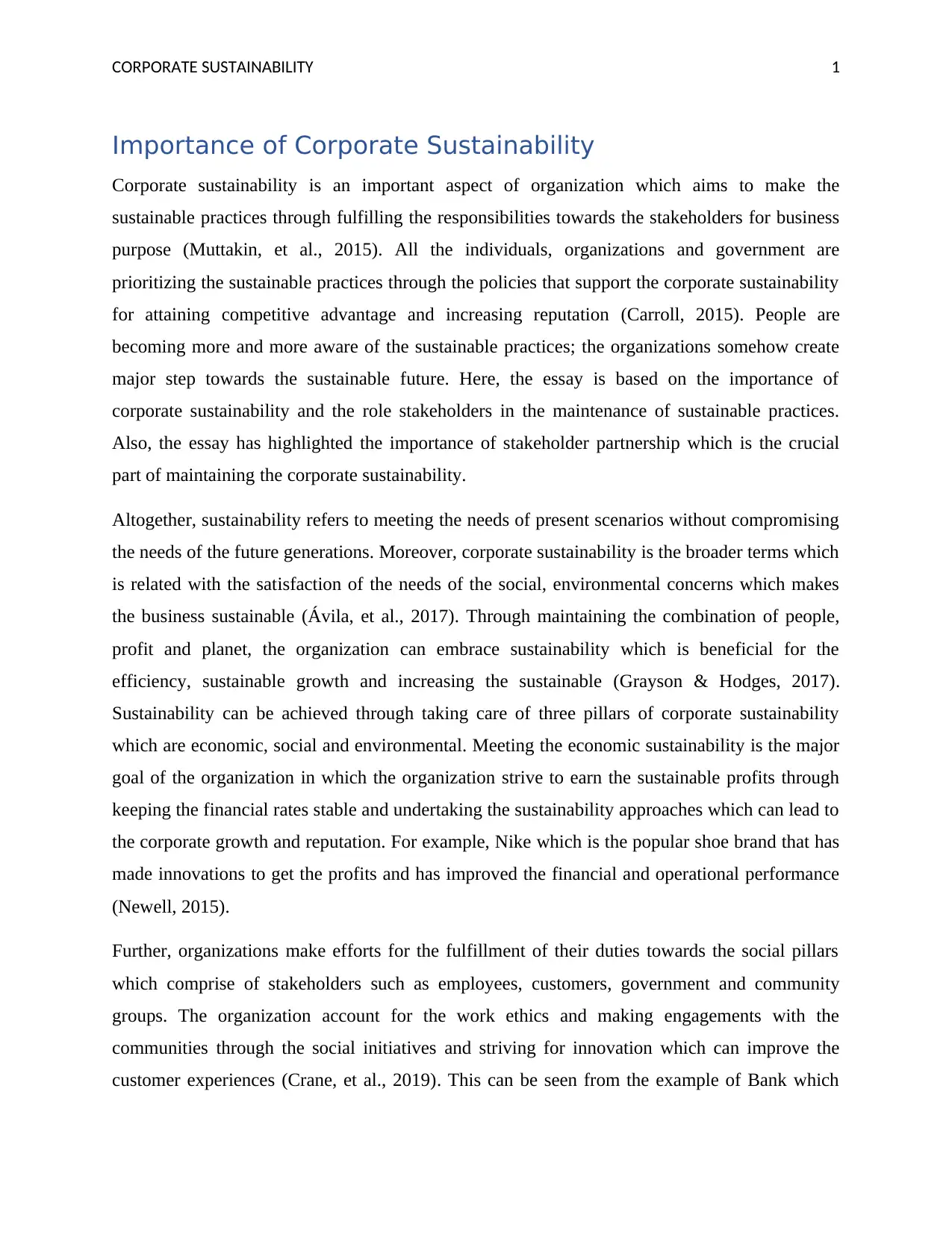
CORPORATE SUSTAINABILITY 1
Importance of Corporate Sustainability
Corporate sustainability is an important aspect of organization which aims to make the
sustainable practices through fulfilling the responsibilities towards the stakeholders for business
purpose (Muttakin, et al., 2015). All the individuals, organizations and government are
prioritizing the sustainable practices through the policies that support the corporate sustainability
for attaining competitive advantage and increasing reputation (Carroll, 2015). People are
becoming more and more aware of the sustainable practices; the organizations somehow create
major step towards the sustainable future. Here, the essay is based on the importance of
corporate sustainability and the role stakeholders in the maintenance of sustainable practices.
Also, the essay has highlighted the importance of stakeholder partnership which is the crucial
part of maintaining the corporate sustainability.
Altogether, sustainability refers to meeting the needs of present scenarios without compromising
the needs of the future generations. Moreover, corporate sustainability is the broader terms which
is related with the satisfaction of the needs of the social, environmental concerns which makes
the business sustainable (Ávila, et al., 2017). Through maintaining the combination of people,
profit and planet, the organization can embrace sustainability which is beneficial for the
efficiency, sustainable growth and increasing the sustainable (Grayson & Hodges, 2017).
Sustainability can be achieved through taking care of three pillars of corporate sustainability
which are economic, social and environmental. Meeting the economic sustainability is the major
goal of the organization in which the organization strive to earn the sustainable profits through
keeping the financial rates stable and undertaking the sustainability approaches which can lead to
the corporate growth and reputation. For example, Nike which is the popular shoe brand that has
made innovations to get the profits and has improved the financial and operational performance
(Newell, 2015).
Further, organizations make efforts for the fulfillment of their duties towards the social pillars
which comprise of stakeholders such as employees, customers, government and community
groups. The organization account for the work ethics and making engagements with the
communities through the social initiatives and striving for innovation which can improve the
customer experiences (Crane, et al., 2019). This can be seen from the example of Bank which
Importance of Corporate Sustainability
Corporate sustainability is an important aspect of organization which aims to make the
sustainable practices through fulfilling the responsibilities towards the stakeholders for business
purpose (Muttakin, et al., 2015). All the individuals, organizations and government are
prioritizing the sustainable practices through the policies that support the corporate sustainability
for attaining competitive advantage and increasing reputation (Carroll, 2015). People are
becoming more and more aware of the sustainable practices; the organizations somehow create
major step towards the sustainable future. Here, the essay is based on the importance of
corporate sustainability and the role stakeholders in the maintenance of sustainable practices.
Also, the essay has highlighted the importance of stakeholder partnership which is the crucial
part of maintaining the corporate sustainability.
Altogether, sustainability refers to meeting the needs of present scenarios without compromising
the needs of the future generations. Moreover, corporate sustainability is the broader terms which
is related with the satisfaction of the needs of the social, environmental concerns which makes
the business sustainable (Ávila, et al., 2017). Through maintaining the combination of people,
profit and planet, the organization can embrace sustainability which is beneficial for the
efficiency, sustainable growth and increasing the sustainable (Grayson & Hodges, 2017).
Sustainability can be achieved through taking care of three pillars of corporate sustainability
which are economic, social and environmental. Meeting the economic sustainability is the major
goal of the organization in which the organization strive to earn the sustainable profits through
keeping the financial rates stable and undertaking the sustainability approaches which can lead to
the corporate growth and reputation. For example, Nike which is the popular shoe brand that has
made innovations to get the profits and has improved the financial and operational performance
(Newell, 2015).
Further, organizations make efforts for the fulfillment of their duties towards the social pillars
which comprise of stakeholders such as employees, customers, government and community
groups. The organization account for the work ethics and making engagements with the
communities through the social initiatives and striving for innovation which can improve the
customer experiences (Crane, et al., 2019). This can be seen from the example of Bank which
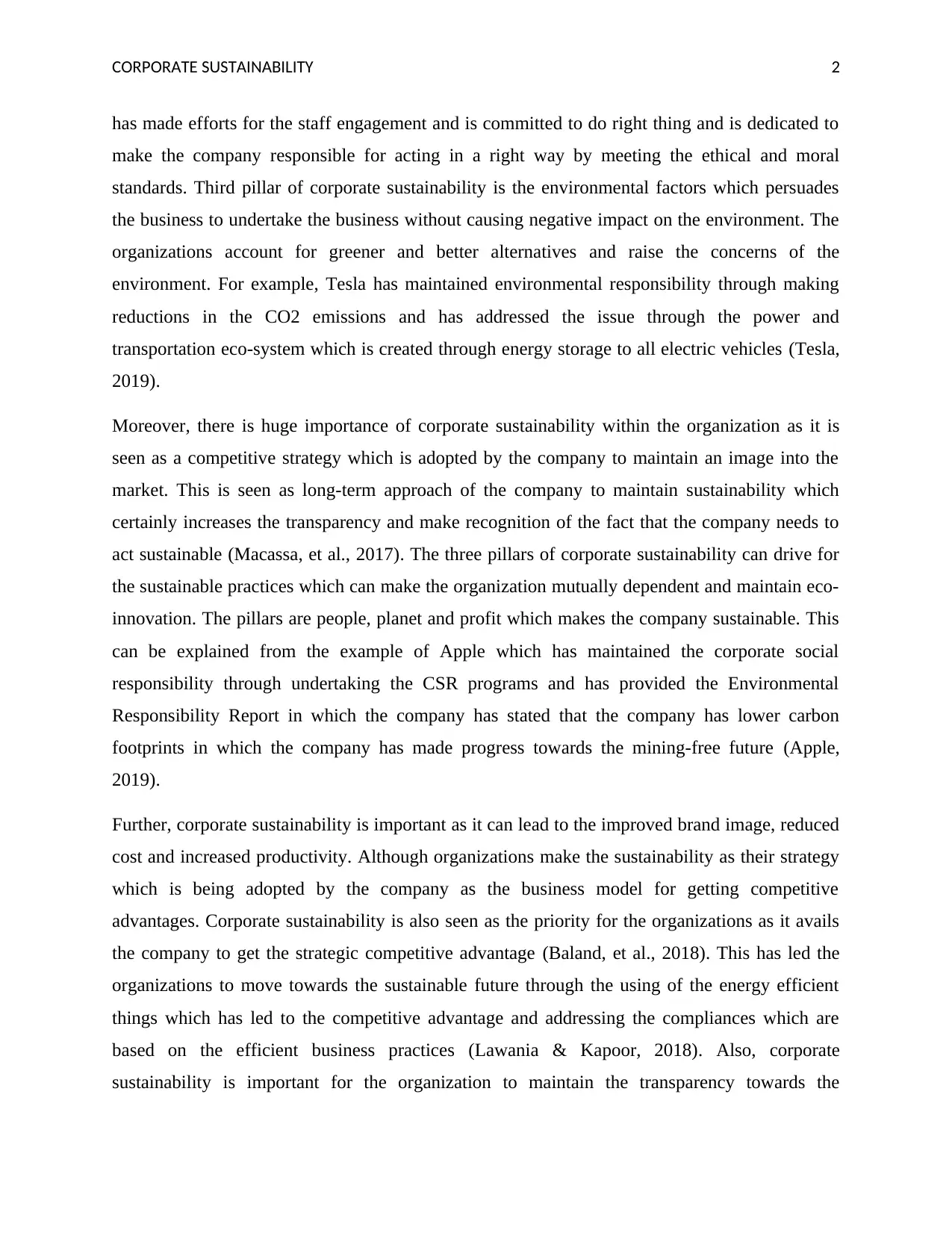
CORPORATE SUSTAINABILITY 2
has made efforts for the staff engagement and is committed to do right thing and is dedicated to
make the company responsible for acting in a right way by meeting the ethical and moral
standards. Third pillar of corporate sustainability is the environmental factors which persuades
the business to undertake the business without causing negative impact on the environment. The
organizations account for greener and better alternatives and raise the concerns of the
environment. For example, Tesla has maintained environmental responsibility through making
reductions in the CO2 emissions and has addressed the issue through the power and
transportation eco-system which is created through energy storage to all electric vehicles (Tesla,
2019).
Moreover, there is huge importance of corporate sustainability within the organization as it is
seen as a competitive strategy which is adopted by the company to maintain an image into the
market. This is seen as long-term approach of the company to maintain sustainability which
certainly increases the transparency and make recognition of the fact that the company needs to
act sustainable (Macassa, et al., 2017). The three pillars of corporate sustainability can drive for
the sustainable practices which can make the organization mutually dependent and maintain eco-
innovation. The pillars are people, planet and profit which makes the company sustainable. This
can be explained from the example of Apple which has maintained the corporate social
responsibility through undertaking the CSR programs and has provided the Environmental
Responsibility Report in which the company has stated that the company has lower carbon
footprints in which the company has made progress towards the mining-free future (Apple,
2019).
Further, corporate sustainability is important as it can lead to the improved brand image, reduced
cost and increased productivity. Although organizations make the sustainability as their strategy
which is being adopted by the company as the business model for getting competitive
advantages. Corporate sustainability is also seen as the priority for the organizations as it avails
the company to get the strategic competitive advantage (Baland, et al., 2018). This has led the
organizations to move towards the sustainable future through the using of the energy efficient
things which has led to the competitive advantage and addressing the compliances which are
based on the efficient business practices (Lawania & Kapoor, 2018). Also, corporate
sustainability is important for the organization to maintain the transparency towards the
has made efforts for the staff engagement and is committed to do right thing and is dedicated to
make the company responsible for acting in a right way by meeting the ethical and moral
standards. Third pillar of corporate sustainability is the environmental factors which persuades
the business to undertake the business without causing negative impact on the environment. The
organizations account for greener and better alternatives and raise the concerns of the
environment. For example, Tesla has maintained environmental responsibility through making
reductions in the CO2 emissions and has addressed the issue through the power and
transportation eco-system which is created through energy storage to all electric vehicles (Tesla,
2019).
Moreover, there is huge importance of corporate sustainability within the organization as it is
seen as a competitive strategy which is adopted by the company to maintain an image into the
market. This is seen as long-term approach of the company to maintain sustainability which
certainly increases the transparency and make recognition of the fact that the company needs to
act sustainable (Macassa, et al., 2017). The three pillars of corporate sustainability can drive for
the sustainable practices which can make the organization mutually dependent and maintain eco-
innovation. The pillars are people, planet and profit which makes the company sustainable. This
can be explained from the example of Apple which has maintained the corporate social
responsibility through undertaking the CSR programs and has provided the Environmental
Responsibility Report in which the company has stated that the company has lower carbon
footprints in which the company has made progress towards the mining-free future (Apple,
2019).
Further, corporate sustainability is important as it can lead to the improved brand image, reduced
cost and increased productivity. Although organizations make the sustainability as their strategy
which is being adopted by the company as the business model for getting competitive
advantages. Corporate sustainability is also seen as the priority for the organizations as it avails
the company to get the strategic competitive advantage (Baland, et al., 2018). This has led the
organizations to move towards the sustainable future through the using of the energy efficient
things which has led to the competitive advantage and addressing the compliances which are
based on the efficient business practices (Lawania & Kapoor, 2018). Also, corporate
sustainability is important for the organization to maintain the transparency towards the
⊘ This is a preview!⊘
Do you want full access?
Subscribe today to unlock all pages.

Trusted by 1+ million students worldwide
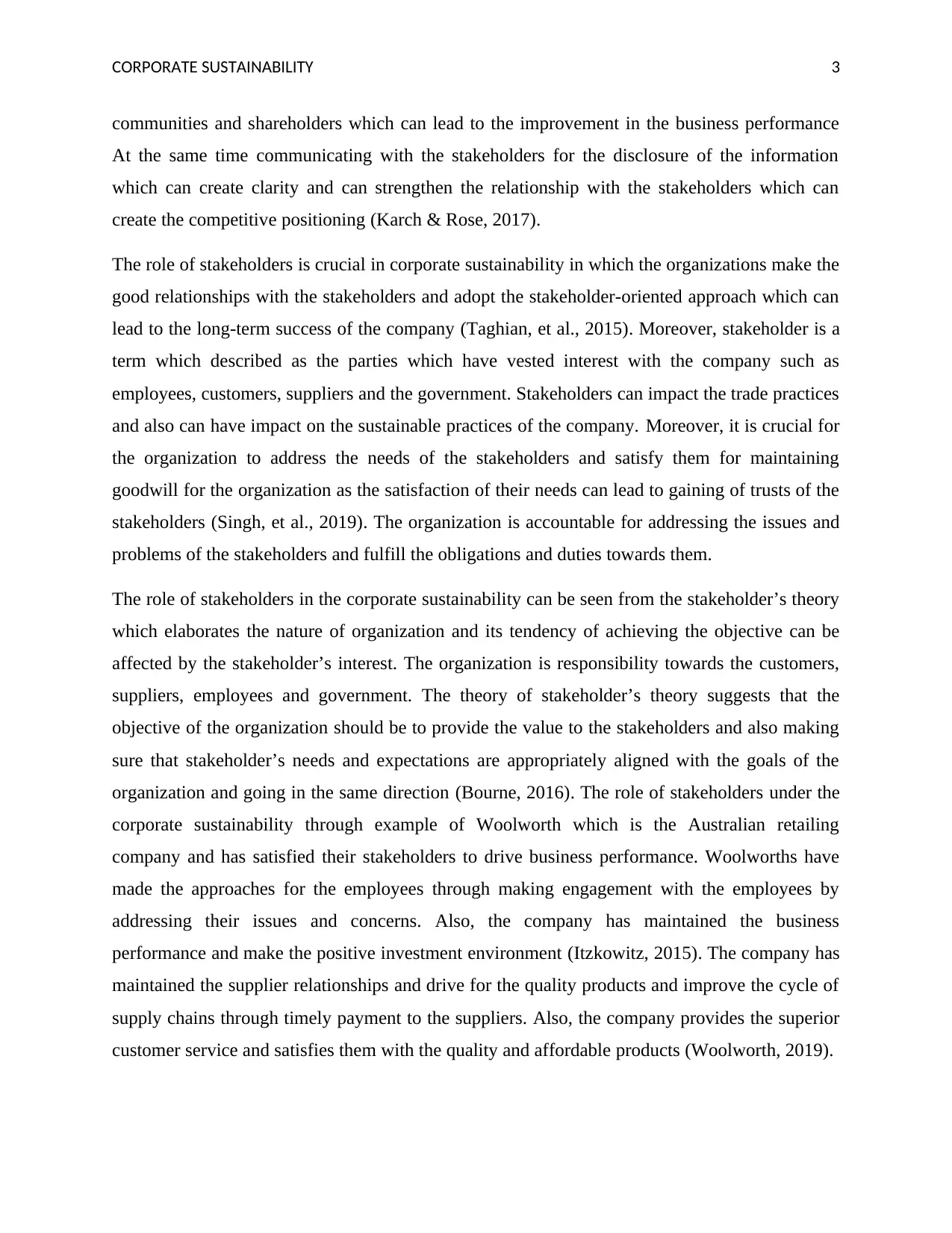
CORPORATE SUSTAINABILITY 3
communities and shareholders which can lead to the improvement in the business performance
At the same time communicating with the stakeholders for the disclosure of the information
which can create clarity and can strengthen the relationship with the stakeholders which can
create the competitive positioning (Karch & Rose, 2017).
The role of stakeholders is crucial in corporate sustainability in which the organizations make the
good relationships with the stakeholders and adopt the stakeholder-oriented approach which can
lead to the long-term success of the company (Taghian, et al., 2015). Moreover, stakeholder is a
term which described as the parties which have vested interest with the company such as
employees, customers, suppliers and the government. Stakeholders can impact the trade practices
and also can have impact on the sustainable practices of the company. Moreover, it is crucial for
the organization to address the needs of the stakeholders and satisfy them for maintaining
goodwill for the organization as the satisfaction of their needs can lead to gaining of trusts of the
stakeholders (Singh, et al., 2019). The organization is accountable for addressing the issues and
problems of the stakeholders and fulfill the obligations and duties towards them.
The role of stakeholders in the corporate sustainability can be seen from the stakeholder’s theory
which elaborates the nature of organization and its tendency of achieving the objective can be
affected by the stakeholder’s interest. The organization is responsibility towards the customers,
suppliers, employees and government. The theory of stakeholder’s theory suggests that the
objective of the organization should be to provide the value to the stakeholders and also making
sure that stakeholder’s needs and expectations are appropriately aligned with the goals of the
organization and going in the same direction (Bourne, 2016). The role of stakeholders under the
corporate sustainability through example of Woolworth which is the Australian retailing
company and has satisfied their stakeholders to drive business performance. Woolworths have
made the approaches for the employees through making engagement with the employees by
addressing their issues and concerns. Also, the company has maintained the business
performance and make the positive investment environment (Itzkowitz, 2015). The company has
maintained the supplier relationships and drive for the quality products and improve the cycle of
supply chains through timely payment to the suppliers. Also, the company provides the superior
customer service and satisfies them with the quality and affordable products (Woolworth, 2019).
communities and shareholders which can lead to the improvement in the business performance
At the same time communicating with the stakeholders for the disclosure of the information
which can create clarity and can strengthen the relationship with the stakeholders which can
create the competitive positioning (Karch & Rose, 2017).
The role of stakeholders is crucial in corporate sustainability in which the organizations make the
good relationships with the stakeholders and adopt the stakeholder-oriented approach which can
lead to the long-term success of the company (Taghian, et al., 2015). Moreover, stakeholder is a
term which described as the parties which have vested interest with the company such as
employees, customers, suppliers and the government. Stakeholders can impact the trade practices
and also can have impact on the sustainable practices of the company. Moreover, it is crucial for
the organization to address the needs of the stakeholders and satisfy them for maintaining
goodwill for the organization as the satisfaction of their needs can lead to gaining of trusts of the
stakeholders (Singh, et al., 2019). The organization is accountable for addressing the issues and
problems of the stakeholders and fulfill the obligations and duties towards them.
The role of stakeholders in the corporate sustainability can be seen from the stakeholder’s theory
which elaborates the nature of organization and its tendency of achieving the objective can be
affected by the stakeholder’s interest. The organization is responsibility towards the customers,
suppliers, employees and government. The theory of stakeholder’s theory suggests that the
objective of the organization should be to provide the value to the stakeholders and also making
sure that stakeholder’s needs and expectations are appropriately aligned with the goals of the
organization and going in the same direction (Bourne, 2016). The role of stakeholders under the
corporate sustainability through example of Woolworth which is the Australian retailing
company and has satisfied their stakeholders to drive business performance. Woolworths have
made the approaches for the employees through making engagement with the employees by
addressing their issues and concerns. Also, the company has maintained the business
performance and make the positive investment environment (Itzkowitz, 2015). The company has
maintained the supplier relationships and drive for the quality products and improve the cycle of
supply chains through timely payment to the suppliers. Also, the company provides the superior
customer service and satisfies them with the quality and affordable products (Woolworth, 2019).
Paraphrase This Document
Need a fresh take? Get an instant paraphrase of this document with our AI Paraphraser
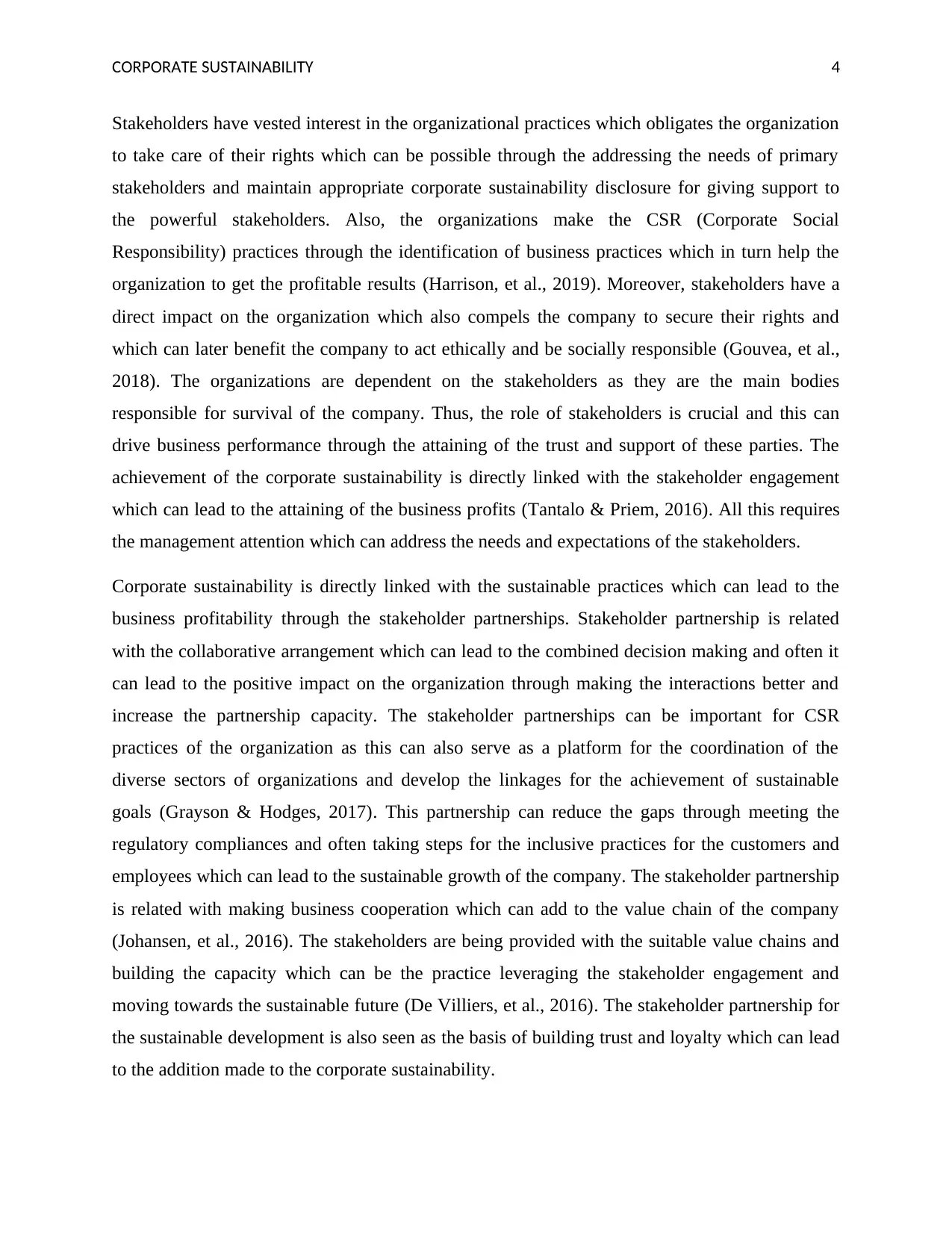
CORPORATE SUSTAINABILITY 4
Stakeholders have vested interest in the organizational practices which obligates the organization
to take care of their rights which can be possible through the addressing the needs of primary
stakeholders and maintain appropriate corporate sustainability disclosure for giving support to
the powerful stakeholders. Also, the organizations make the CSR (Corporate Social
Responsibility) practices through the identification of business practices which in turn help the
organization to get the profitable results (Harrison, et al., 2019). Moreover, stakeholders have a
direct impact on the organization which also compels the company to secure their rights and
which can later benefit the company to act ethically and be socially responsible (Gouvea, et al.,
2018). The organizations are dependent on the stakeholders as they are the main bodies
responsible for survival of the company. Thus, the role of stakeholders is crucial and this can
drive business performance through the attaining of the trust and support of these parties. The
achievement of the corporate sustainability is directly linked with the stakeholder engagement
which can lead to the attaining of the business profits (Tantalo & Priem, 2016). All this requires
the management attention which can address the needs and expectations of the stakeholders.
Corporate sustainability is directly linked with the sustainable practices which can lead to the
business profitability through the stakeholder partnerships. Stakeholder partnership is related
with the collaborative arrangement which can lead to the combined decision making and often it
can lead to the positive impact on the organization through making the interactions better and
increase the partnership capacity. The stakeholder partnerships can be important for CSR
practices of the organization as this can also serve as a platform for the coordination of the
diverse sectors of organizations and develop the linkages for the achievement of sustainable
goals (Grayson & Hodges, 2017). This partnership can reduce the gaps through meeting the
regulatory compliances and often taking steps for the inclusive practices for the customers and
employees which can lead to the sustainable growth of the company. The stakeholder partnership
is related with making business cooperation which can add to the value chain of the company
(Johansen, et al., 2016). The stakeholders are being provided with the suitable value chains and
building the capacity which can be the practice leveraging the stakeholder engagement and
moving towards the sustainable future (De Villiers, et al., 2016). The stakeholder partnership for
the sustainable development is also seen as the basis of building trust and loyalty which can lead
to the addition made to the corporate sustainability.
Stakeholders have vested interest in the organizational practices which obligates the organization
to take care of their rights which can be possible through the addressing the needs of primary
stakeholders and maintain appropriate corporate sustainability disclosure for giving support to
the powerful stakeholders. Also, the organizations make the CSR (Corporate Social
Responsibility) practices through the identification of business practices which in turn help the
organization to get the profitable results (Harrison, et al., 2019). Moreover, stakeholders have a
direct impact on the organization which also compels the company to secure their rights and
which can later benefit the company to act ethically and be socially responsible (Gouvea, et al.,
2018). The organizations are dependent on the stakeholders as they are the main bodies
responsible for survival of the company. Thus, the role of stakeholders is crucial and this can
drive business performance through the attaining of the trust and support of these parties. The
achievement of the corporate sustainability is directly linked with the stakeholder engagement
which can lead to the attaining of the business profits (Tantalo & Priem, 2016). All this requires
the management attention which can address the needs and expectations of the stakeholders.
Corporate sustainability is directly linked with the sustainable practices which can lead to the
business profitability through the stakeholder partnerships. Stakeholder partnership is related
with the collaborative arrangement which can lead to the combined decision making and often it
can lead to the positive impact on the organization through making the interactions better and
increase the partnership capacity. The stakeholder partnerships can be important for CSR
practices of the organization as this can also serve as a platform for the coordination of the
diverse sectors of organizations and develop the linkages for the achievement of sustainable
goals (Grayson & Hodges, 2017). This partnership can reduce the gaps through meeting the
regulatory compliances and often taking steps for the inclusive practices for the customers and
employees which can lead to the sustainable growth of the company. The stakeholder partnership
is related with making business cooperation which can add to the value chain of the company
(Johansen, et al., 2016). The stakeholders are being provided with the suitable value chains and
building the capacity which can be the practice leveraging the stakeholder engagement and
moving towards the sustainable future (De Villiers, et al., 2016). The stakeholder partnership for
the sustainable development is also seen as the basis of building trust and loyalty which can lead
to the addition made to the corporate sustainability.
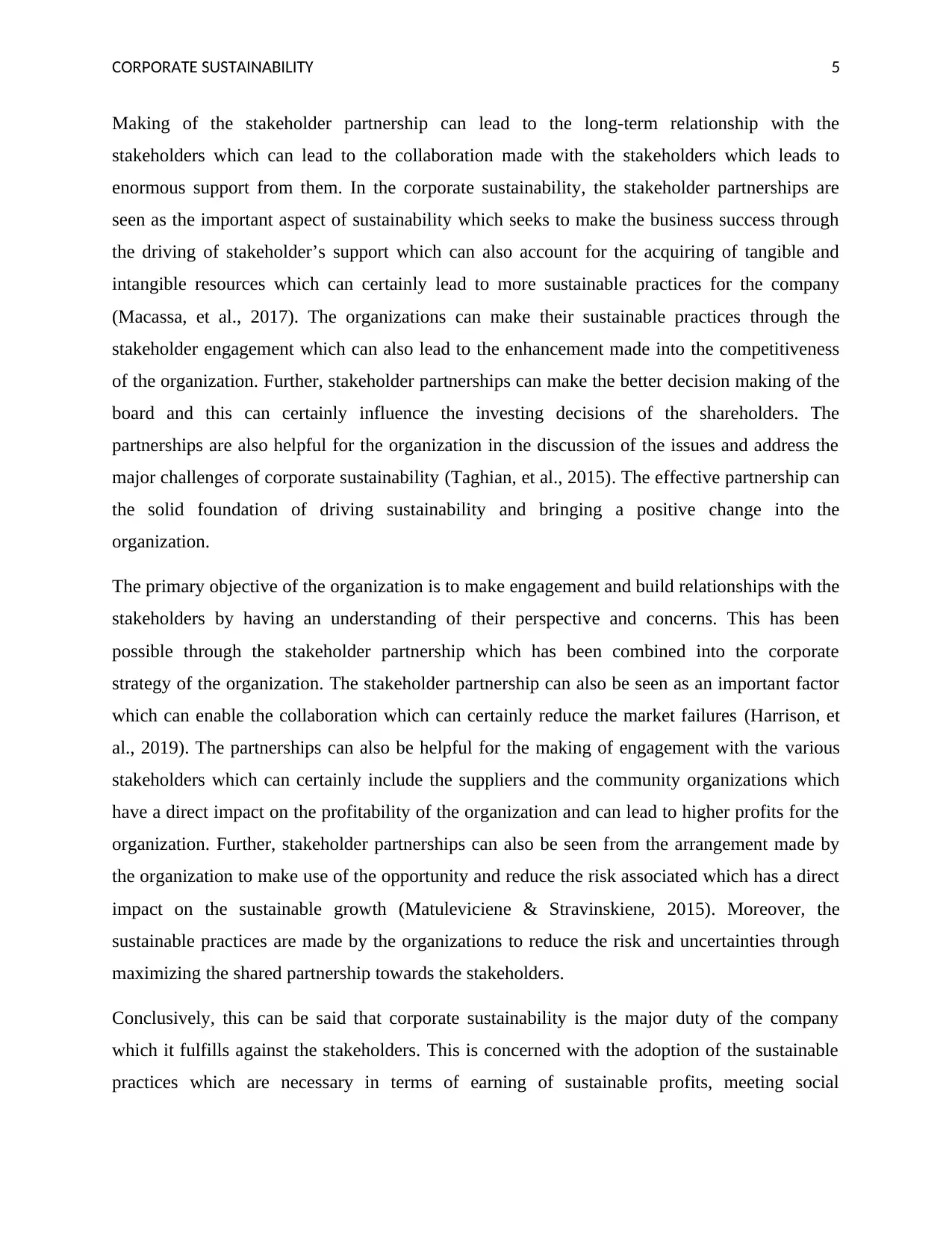
CORPORATE SUSTAINABILITY 5
Making of the stakeholder partnership can lead to the long-term relationship with the
stakeholders which can lead to the collaboration made with the stakeholders which leads to
enormous support from them. In the corporate sustainability, the stakeholder partnerships are
seen as the important aspect of sustainability which seeks to make the business success through
the driving of stakeholder’s support which can also account for the acquiring of tangible and
intangible resources which can certainly lead to more sustainable practices for the company
(Macassa, et al., 2017). The organizations can make their sustainable practices through the
stakeholder engagement which can also lead to the enhancement made into the competitiveness
of the organization. Further, stakeholder partnerships can make the better decision making of the
board and this can certainly influence the investing decisions of the shareholders. The
partnerships are also helpful for the organization in the discussion of the issues and address the
major challenges of corporate sustainability (Taghian, et al., 2015). The effective partnership can
the solid foundation of driving sustainability and bringing a positive change into the
organization.
The primary objective of the organization is to make engagement and build relationships with the
stakeholders by having an understanding of their perspective and concerns. This has been
possible through the stakeholder partnership which has been combined into the corporate
strategy of the organization. The stakeholder partnership can also be seen as an important factor
which can enable the collaboration which can certainly reduce the market failures (Harrison, et
al., 2019). The partnerships can also be helpful for the making of engagement with the various
stakeholders which can certainly include the suppliers and the community organizations which
have a direct impact on the profitability of the organization and can lead to higher profits for the
organization. Further, stakeholder partnerships can also be seen from the arrangement made by
the organization to make use of the opportunity and reduce the risk associated which has a direct
impact on the sustainable growth (Matuleviciene & Stravinskiene, 2015). Moreover, the
sustainable practices are made by the organizations to reduce the risk and uncertainties through
maximizing the shared partnership towards the stakeholders.
Conclusively, this can be said that corporate sustainability is the major duty of the company
which it fulfills against the stakeholders. This is concerned with the adoption of the sustainable
practices which are necessary in terms of earning of sustainable profits, meeting social
Making of the stakeholder partnership can lead to the long-term relationship with the
stakeholders which can lead to the collaboration made with the stakeholders which leads to
enormous support from them. In the corporate sustainability, the stakeholder partnerships are
seen as the important aspect of sustainability which seeks to make the business success through
the driving of stakeholder’s support which can also account for the acquiring of tangible and
intangible resources which can certainly lead to more sustainable practices for the company
(Macassa, et al., 2017). The organizations can make their sustainable practices through the
stakeholder engagement which can also lead to the enhancement made into the competitiveness
of the organization. Further, stakeholder partnerships can make the better decision making of the
board and this can certainly influence the investing decisions of the shareholders. The
partnerships are also helpful for the organization in the discussion of the issues and address the
major challenges of corporate sustainability (Taghian, et al., 2015). The effective partnership can
the solid foundation of driving sustainability and bringing a positive change into the
organization.
The primary objective of the organization is to make engagement and build relationships with the
stakeholders by having an understanding of their perspective and concerns. This has been
possible through the stakeholder partnership which has been combined into the corporate
strategy of the organization. The stakeholder partnership can also be seen as an important factor
which can enable the collaboration which can certainly reduce the market failures (Harrison, et
al., 2019). The partnerships can also be helpful for the making of engagement with the various
stakeholders which can certainly include the suppliers and the community organizations which
have a direct impact on the profitability of the organization and can lead to higher profits for the
organization. Further, stakeholder partnerships can also be seen from the arrangement made by
the organization to make use of the opportunity and reduce the risk associated which has a direct
impact on the sustainable growth (Matuleviciene & Stravinskiene, 2015). Moreover, the
sustainable practices are made by the organizations to reduce the risk and uncertainties through
maximizing the shared partnership towards the stakeholders.
Conclusively, this can be said that corporate sustainability is the major duty of the company
which it fulfills against the stakeholders. This is concerned with the adoption of the sustainable
practices which are necessary in terms of earning of sustainable profits, meeting social
⊘ This is a preview!⊘
Do you want full access?
Subscribe today to unlock all pages.

Trusted by 1+ million students worldwide
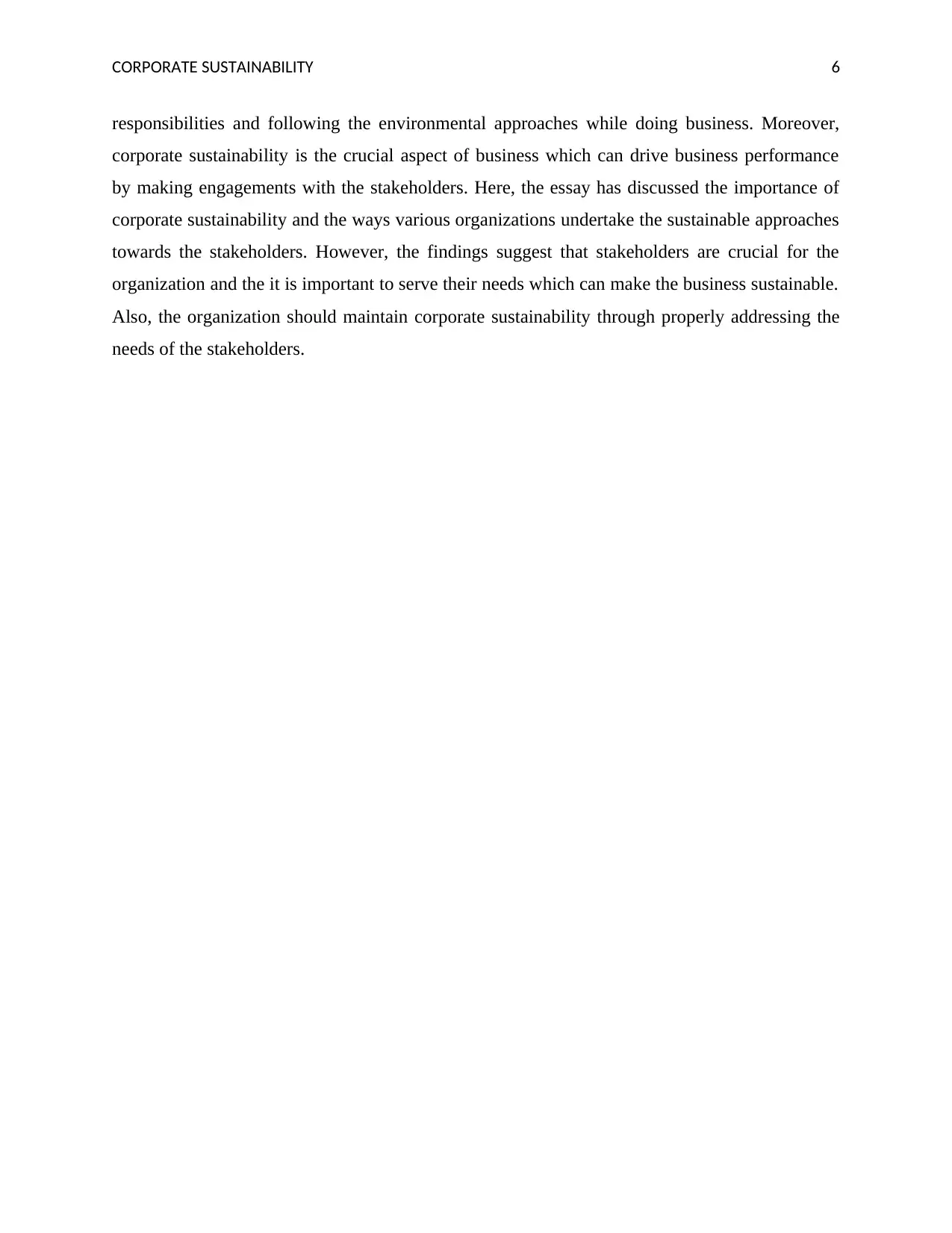
CORPORATE SUSTAINABILITY 6
responsibilities and following the environmental approaches while doing business. Moreover,
corporate sustainability is the crucial aspect of business which can drive business performance
by making engagements with the stakeholders. Here, the essay has discussed the importance of
corporate sustainability and the ways various organizations undertake the sustainable approaches
towards the stakeholders. However, the findings suggest that stakeholders are crucial for the
organization and the it is important to serve their needs which can make the business sustainable.
Also, the organization should maintain corporate sustainability through properly addressing the
needs of the stakeholders.
responsibilities and following the environmental approaches while doing business. Moreover,
corporate sustainability is the crucial aspect of business which can drive business performance
by making engagements with the stakeholders. Here, the essay has discussed the importance of
corporate sustainability and the ways various organizations undertake the sustainable approaches
towards the stakeholders. However, the findings suggest that stakeholders are crucial for the
organization and the it is important to serve their needs which can make the business sustainable.
Also, the organization should maintain corporate sustainability through properly addressing the
needs of the stakeholders.
Paraphrase This Document
Need a fresh take? Get an instant paraphrase of this document with our AI Paraphraser
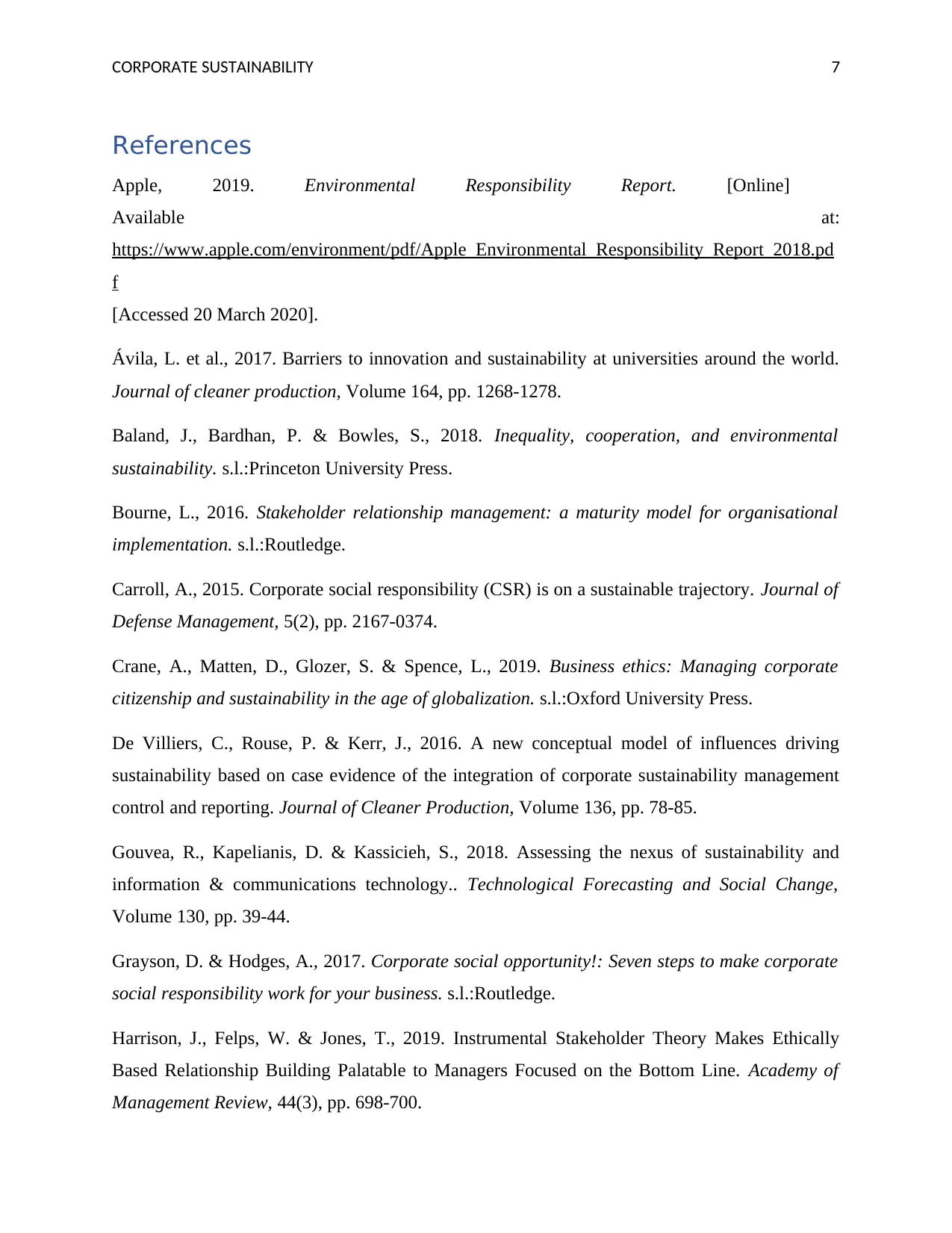
CORPORATE SUSTAINABILITY 7
References
Apple, 2019. Environmental Responsibility Report. [Online]
Available at:
https://www.apple.com/environment/pdf/Apple_Environmental_Responsibility_Report_2018.pd
f
[Accessed 20 March 2020].
Ávila, L. et al., 2017. Barriers to innovation and sustainability at universities around the world.
Journal of cleaner production, Volume 164, pp. 1268-1278.
Baland, J., Bardhan, P. & Bowles, S., 2018. Inequality, cooperation, and environmental
sustainability. s.l.:Princeton University Press.
Bourne, L., 2016. Stakeholder relationship management: a maturity model for organisational
implementation. s.l.:Routledge.
Carroll, A., 2015. Corporate social responsibility (CSR) is on a sustainable trajectory. Journal of
Defense Management, 5(2), pp. 2167-0374.
Crane, A., Matten, D., Glozer, S. & Spence, L., 2019. Business ethics: Managing corporate
citizenship and sustainability in the age of globalization. s.l.:Oxford University Press.
De Villiers, C., Rouse, P. & Kerr, J., 2016. A new conceptual model of influences driving
sustainability based on case evidence of the integration of corporate sustainability management
control and reporting. Journal of Cleaner Production, Volume 136, pp. 78-85.
Gouvea, R., Kapelianis, D. & Kassicieh, S., 2018. Assessing the nexus of sustainability and
information & communications technology.. Technological Forecasting and Social Change,
Volume 130, pp. 39-44.
Grayson, D. & Hodges, A., 2017. Corporate social opportunity!: Seven steps to make corporate
social responsibility work for your business. s.l.:Routledge.
Harrison, J., Felps, W. & Jones, T., 2019. Instrumental Stakeholder Theory Makes Ethically
Based Relationship Building Palatable to Managers Focused on the Bottom Line. Academy of
Management Review, 44(3), pp. 698-700.
References
Apple, 2019. Environmental Responsibility Report. [Online]
Available at:
https://www.apple.com/environment/pdf/Apple_Environmental_Responsibility_Report_2018.pd
f
[Accessed 20 March 2020].
Ávila, L. et al., 2017. Barriers to innovation and sustainability at universities around the world.
Journal of cleaner production, Volume 164, pp. 1268-1278.
Baland, J., Bardhan, P. & Bowles, S., 2018. Inequality, cooperation, and environmental
sustainability. s.l.:Princeton University Press.
Bourne, L., 2016. Stakeholder relationship management: a maturity model for organisational
implementation. s.l.:Routledge.
Carroll, A., 2015. Corporate social responsibility (CSR) is on a sustainable trajectory. Journal of
Defense Management, 5(2), pp. 2167-0374.
Crane, A., Matten, D., Glozer, S. & Spence, L., 2019. Business ethics: Managing corporate
citizenship and sustainability in the age of globalization. s.l.:Oxford University Press.
De Villiers, C., Rouse, P. & Kerr, J., 2016. A new conceptual model of influences driving
sustainability based on case evidence of the integration of corporate sustainability management
control and reporting. Journal of Cleaner Production, Volume 136, pp. 78-85.
Gouvea, R., Kapelianis, D. & Kassicieh, S., 2018. Assessing the nexus of sustainability and
information & communications technology.. Technological Forecasting and Social Change,
Volume 130, pp. 39-44.
Grayson, D. & Hodges, A., 2017. Corporate social opportunity!: Seven steps to make corporate
social responsibility work for your business. s.l.:Routledge.
Harrison, J., Felps, W. & Jones, T., 2019. Instrumental Stakeholder Theory Makes Ethically
Based Relationship Building Palatable to Managers Focused on the Bottom Line. Academy of
Management Review, 44(3), pp. 698-700.
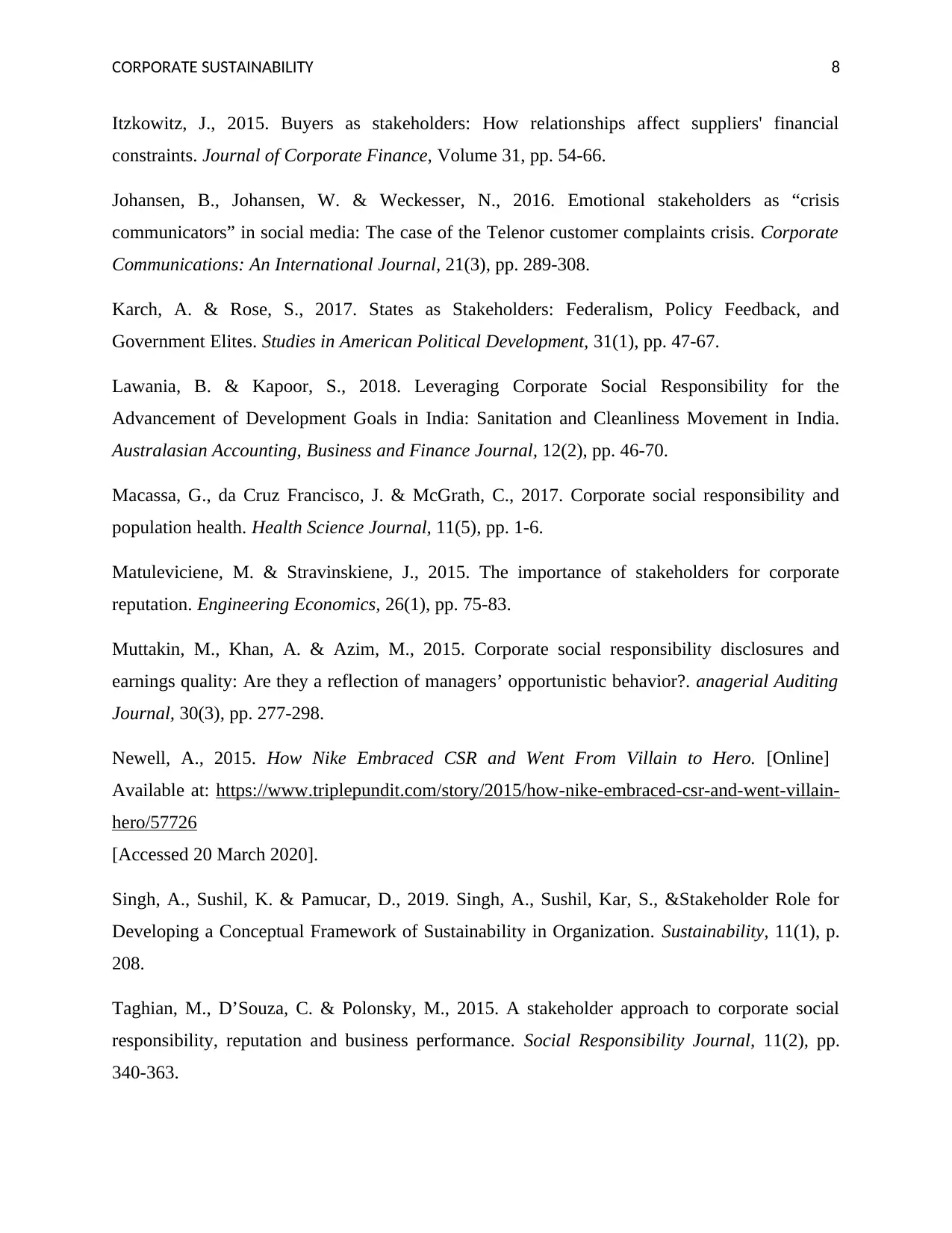
CORPORATE SUSTAINABILITY 8
Itzkowitz, J., 2015. Buyers as stakeholders: How relationships affect suppliers' financial
constraints. Journal of Corporate Finance, Volume 31, pp. 54-66.
Johansen, B., Johansen, W. & Weckesser, N., 2016. Emotional stakeholders as “crisis
communicators” in social media: The case of the Telenor customer complaints crisis. Corporate
Communications: An International Journal, 21(3), pp. 289-308.
Karch, A. & Rose, S., 2017. States as Stakeholders: Federalism, Policy Feedback, and
Government Elites. Studies in American Political Development, 31(1), pp. 47-67.
Lawania, B. & Kapoor, S., 2018. Leveraging Corporate Social Responsibility for the
Advancement of Development Goals in India: Sanitation and Cleanliness Movement in India.
Australasian Accounting, Business and Finance Journal, 12(2), pp. 46-70.
Macassa, G., da Cruz Francisco, J. & McGrath, C., 2017. Corporate social responsibility and
population health. Health Science Journal, 11(5), pp. 1-6.
Matuleviciene, M. & Stravinskiene, J., 2015. The importance of stakeholders for corporate
reputation. Engineering Economics, 26(1), pp. 75-83.
Muttakin, M., Khan, A. & Azim, M., 2015. Corporate social responsibility disclosures and
earnings quality: Are they a reflection of managers’ opportunistic behavior?. anagerial Auditing
Journal, 30(3), pp. 277-298.
Newell, A., 2015. How Nike Embraced CSR and Went From Villain to Hero. [Online]
Available at: https://www.triplepundit.com/story/2015/how-nike-embraced-csr-and-went-villain-
hero/57726
[Accessed 20 March 2020].
Singh, A., Sushil, K. & Pamucar, D., 2019. Singh, A., Sushil, Kar, S., &Stakeholder Role for
Developing a Conceptual Framework of Sustainability in Organization. Sustainability, 11(1), p.
208.
Taghian, M., D’Souza, C. & Polonsky, M., 2015. A stakeholder approach to corporate social
responsibility, reputation and business performance. Social Responsibility Journal, 11(2), pp.
340-363.
Itzkowitz, J., 2015. Buyers as stakeholders: How relationships affect suppliers' financial
constraints. Journal of Corporate Finance, Volume 31, pp. 54-66.
Johansen, B., Johansen, W. & Weckesser, N., 2016. Emotional stakeholders as “crisis
communicators” in social media: The case of the Telenor customer complaints crisis. Corporate
Communications: An International Journal, 21(3), pp. 289-308.
Karch, A. & Rose, S., 2017. States as Stakeholders: Federalism, Policy Feedback, and
Government Elites. Studies in American Political Development, 31(1), pp. 47-67.
Lawania, B. & Kapoor, S., 2018. Leveraging Corporate Social Responsibility for the
Advancement of Development Goals in India: Sanitation and Cleanliness Movement in India.
Australasian Accounting, Business and Finance Journal, 12(2), pp. 46-70.
Macassa, G., da Cruz Francisco, J. & McGrath, C., 2017. Corporate social responsibility and
population health. Health Science Journal, 11(5), pp. 1-6.
Matuleviciene, M. & Stravinskiene, J., 2015. The importance of stakeholders for corporate
reputation. Engineering Economics, 26(1), pp. 75-83.
Muttakin, M., Khan, A. & Azim, M., 2015. Corporate social responsibility disclosures and
earnings quality: Are they a reflection of managers’ opportunistic behavior?. anagerial Auditing
Journal, 30(3), pp. 277-298.
Newell, A., 2015. How Nike Embraced CSR and Went From Villain to Hero. [Online]
Available at: https://www.triplepundit.com/story/2015/how-nike-embraced-csr-and-went-villain-
hero/57726
[Accessed 20 March 2020].
Singh, A., Sushil, K. & Pamucar, D., 2019. Singh, A., Sushil, Kar, S., &Stakeholder Role for
Developing a Conceptual Framework of Sustainability in Organization. Sustainability, 11(1), p.
208.
Taghian, M., D’Souza, C. & Polonsky, M., 2015. A stakeholder approach to corporate social
responsibility, reputation and business performance. Social Responsibility Journal, 11(2), pp.
340-363.
⊘ This is a preview!⊘
Do you want full access?
Subscribe today to unlock all pages.

Trusted by 1+ million students worldwide
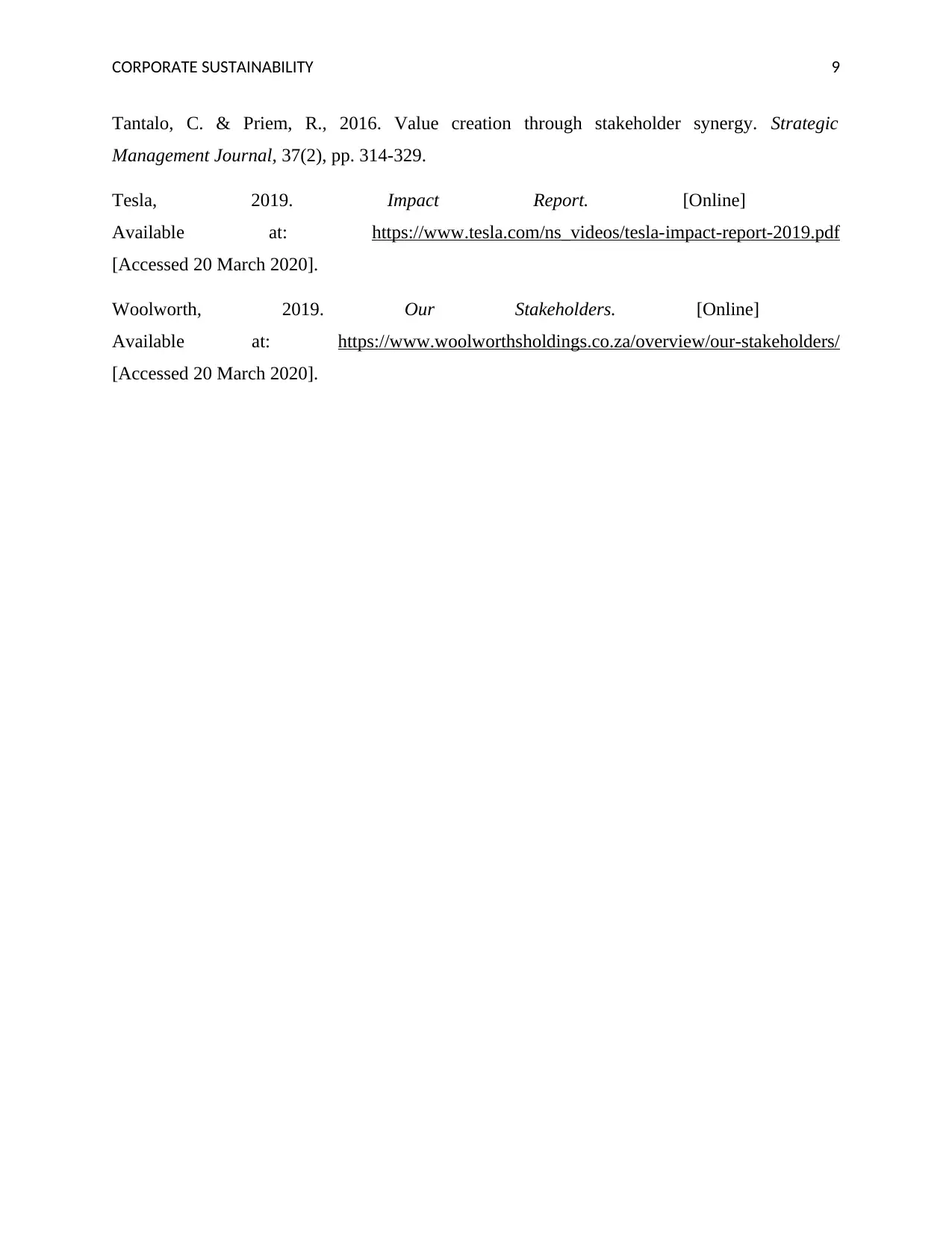
CORPORATE SUSTAINABILITY 9
Tantalo, C. & Priem, R., 2016. Value creation through stakeholder synergy. Strategic
Management Journal, 37(2), pp. 314-329.
Tesla, 2019. Impact Report. [Online]
Available at: https://www.tesla.com/ns_videos/tesla-impact-report-2019.pdf
[Accessed 20 March 2020].
Woolworth, 2019. Our Stakeholders. [Online]
Available at: https://www.woolworthsholdings.co.za/overview/our-stakeholders/
[Accessed 20 March 2020].
Tantalo, C. & Priem, R., 2016. Value creation through stakeholder synergy. Strategic
Management Journal, 37(2), pp. 314-329.
Tesla, 2019. Impact Report. [Online]
Available at: https://www.tesla.com/ns_videos/tesla-impact-report-2019.pdf
[Accessed 20 March 2020].
Woolworth, 2019. Our Stakeholders. [Online]
Available at: https://www.woolworthsholdings.co.za/overview/our-stakeholders/
[Accessed 20 March 2020].
1 out of 10
Related Documents
Your All-in-One AI-Powered Toolkit for Academic Success.
+13062052269
info@desklib.com
Available 24*7 on WhatsApp / Email
![[object Object]](/_next/static/media/star-bottom.7253800d.svg)
Unlock your academic potential
Copyright © 2020–2025 A2Z Services. All Rights Reserved. Developed and managed by ZUCOL.





